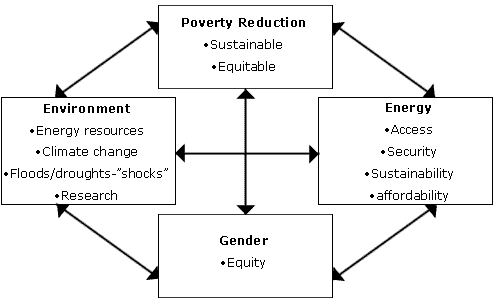| 1. Introduction |
| |
- There is a connection between access to modern energy services and development
- Improved access to energy services are necessary for development
- Majority of poor depend on biomass fuels for energy needs
- Women are at the center of the energy economy of the poor and marginalized
- Time and energy poverty lead to income poverty
- Poverty, particularly for women is more than income deficiency
- QUESTION? How do we change this state of affairs? “In search of the missing links?”
2. Conceptualizing poverty
- Inability of an individual, family or a household to meet basic needs or minimal standards
- Market failures central to the process of impoverishment-“entitlement failures” result
- Thus, poverty not simply a matter of few assets but importantly about constraints (Carter and May, 1999).
- Poverty has many dimensions—important to consider absolute and relative poverty
- Caveat—norms used as measures of poverty differ in time and space
- Distinction needed between transient and chronic poverty—because the causes differ; meaning strategies should differ
- Nevertheless, income remains a good proxy of poverty, as it is a key determinant of other aspects of welfare!
3. Linking gender, energy and poverty
|

|
4. Energy, poverty and gender in space
| Country |
% Of rural population 1995 |
GNP per head (US%) |
Energy consumption (kgoe') 1994 |
Access to electricity 1999 |
Biomass consumption 1993 |
| Angola |
67.8 |
340 |
89 |
9 |
59.1 |
| Botswana |
69.2 |
3.020 |
387 |
13 |
- |
| DRC |
70.9 |
110 |
45 |
5 |
83.5 |
| Lesotho |
76.9 |
670 |
- |
3 |
- |
| Malawi |
86.5 |
180 |
39 |
3.2 |
86.4 |
| Mauritius |
59.4 |
3.690 |
387 |
5 |
47.2 |
| Mozambique |
65.8 |
90 |
40 |
5 |
85.3 |
| Namibia |
62.6 |
2.080 |
- |
11 |
- |
| Seychelles |
34.9 |
6.960 |
- |
- |
- |
| South Africa |
49.2 |
3.140 |
2.146 |
48 |
- |
| Swaziland |
60.8 |
- |
- |
14 |
- |
| Tanzania |
75.6 |
130 |
34 |
5 |
89.3 |
| Zambia |
56.9 |
430 |
149 |
10 |
71 |
| Zimbabwe |
67.9 |
620 |
438 |
17 |
25.6 |
| Total |
65.9 |
3754 |
16.2 |
'low' |
'high' |
|
5. Summary and way forward
- A situational analysis was presented!
- Challenges remain for SADC governments in terms of providing electricity for 84% of the masses without access to electricity
- Globally, approximately 2billion people do not have access to modern forms of energy such as electricity
- Women and children bore the responsibility of managing the energy economy of poor households
- Because of poverty, conventional modern forms of energy (fossils fuels, and electricity) will remain the fuel of first choice for many poor households for many years to come, while biomass fuels will remain the main fuel of necessity (Barnett, 2000).
- Intervention needed to change such grim prospects!
- I THANK YOU FOR LISTENING!
|


